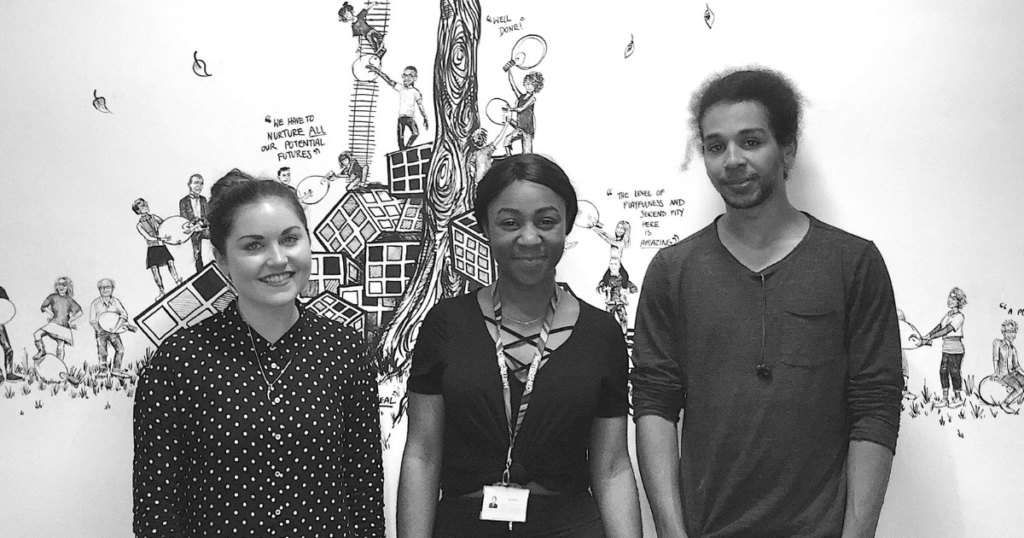It’s no revelation to say that creativity is important for businesses. Less known, however, is the vital implementation of creativity techniques like mind mapping.
Complex problem solving, critical thinking and creativity are the top three skills that will be required in 2020.
As we move towards the Fourth Industrial Revolution, now more than ever, your business ideas need to be unique. They should stand out from the crowd and offer your client or customer a real-world solution that they genuinely need.
Amongst AI, robotics and machine learning developments, there is a need for human creativity, which you can enhance with key techniques and optimum conditions explored in this blog post.
Why?
Creativity needs to be channeled
Creativity is the key ingredient to make the cake, but if we don’t employ the right techniques or use the correct equipment, we can’t harness it properly. If we don’t mix ingredients or use a structure like a tin to bake the cake, all we end up with is a hot mess.
Creativity techniques like mind mapping, brainstorming and structured thinking allow us to channel our creativity through useful outputs whilst giving ourselves freedom and permission to think outside of the box.
When?
Creativity peaks during 20s & 50s
Many people think we are at our most creative when we’re young, but recent studies have revealed there will be more than one creative peak in our lives. Hooray!
Research from Ohio State University states that creativity has two peaks:
- The first creative peak is in our 20s
- The second creative peak is in our 50s
The study investigated previous winners of the Nobel prize in economics, examining when they did their work, the type of breakthroughs they had and what kind of creativity was most prominent as a factor in their work.
Conceptual innovators
The research concluded that the creativity during each peak is different. During our 20s, our creative peak is when we are the best ‘conceptual’ innovators.
At this age, we are radical thinkers who are not yet constrained by the limits of our industries. These thinkers come up with innovative ideas that challenge conventional wisdom.
“Many people think that creativity is exclusively associated with youth, but it really depends what kind of creativity you’re talking about,” said Bruce Weinburg, lead author of the study.
Experimental innovators
During our 50s, we are ‘experimental’ innovators. The kind of creativity we excel at during our 50s uses our experience as leverage.
This type of creativity embodies years of trial, error and industry knowledge to create something revolutionary, often using new or unexpected ways to analyse and interpret information.
Professor Weinburg explains that, “Whether you hit your creative peak early or late in your career depends on whether you have a conceptual or an experimental approach,” so don’t worry if you haven’t had that lightbulb moment yet! You could be an experimental innovator.
If you want to find out more about which creative type you are, Adobe have released a quiz to help you understand more about your creativity, strengths, limitations and who you collaborate with best.
Who?
Individual vs. group creative techniques
Creativity is unique to all of us and we require different conditions for optimum working. To help you understand how well you will work with a team or individually, we’ve created a quick break down of the benefits and limitations of working creatively in a group and alone.
| Individual | Group |
| Less inhibited However comfortable you are team members, sometimes you feel less inhibited working alone; there’s no one to distract or distract you by giggling at a funny idea or offering to make a pot of coffee. | Bouncing ideas Often when we come up with an idea, we can get lost or stuck in the logistics. Having a team around helps you to share, develop and strengthen ideas. You can bounce ideas around and build on from one another. |
| No time pressure Working alone means you can work at your own speed. There’s no need to feel rushed or pressured to stick with the first idea that comes to mind. You can take your time to let those thoughts evolve. | More diverse ideas A variety of life experiences, opinions and expertise results in different ideas that can compliment or even challenge each other. Clashes, connections and collaborations can lead you to an innovation that you may never have reached alone. |
| Less chance of blocking Studies show that sometimes working in groups means we forget our own ideas, getting blocked whilst waiting for our turn to speak. Our energy may be spent on developing other people’s ideas rather than creating our own. | More commitment to the final solution You may feel more invested in seeing an idea through to delivery if you had an input in the creation of it. It’s the same for other people. By working in a group, each team member has a sense of ownership and a stake in the final results. |
Individual vs. group
General conclusions we can draw from this analysis of the benefits and limitations of collaborative vs. individual working:
- Individual working can be better for simple problems, listing ideas or generating broad, overarching themes
- Group working can be better for tackling a complex problem because we can draw on a variety of experiences, expertise and opinions that offer different perspectives.
However, you don’t need to choose just one. You can get the best of both worlds. A problem can require both individual and group working to generate the most creative and effective solutions.
Individual group members can try to tackle a problem alone in their own time, then the group can come together to share ideas and develop them collaboratively.
Here is our formula for a great creative thinking process:
1. Prepare your group
This involves curating a group of people who will compliment and challenge one another’s ideas. It also involved selecting a suitable space for the group to meet.
Anywhere with a round table is great for facilitating effective communication and solid teamwork. Even if you cannot meet up in person, you can use Mind Map Pro for collaborative group work online.
2. Individual work
Present the problem to each individual and ask them to explore it using a creative technique to come up with solutions alone.
3. Group work
After each team member finished creative thinking on their own, it’s time to bring the team together to share their ideas. Invite group members to present their own ideas first and then lead into a group discussion after.
4. Take ideas further
You can use creative techniques listed below to develop ideas further or to generate even more.
5. Evaluate
It’s important to evaluate your ideas. Take a step back and look at the bigger picture. There are lots of ways to evaluate ideas, but here are a few options to get you started:
i. SWOT analysis using Mind Map Pro to analyse strengths, weaknesses, opportunities and threats
ii. Creating a table of stakeholders and evaluating how they would respond to an idea or solution
iii. Voting system using stickers. Ask each group member to vote for their favourite idea.
How?
Creativity techniques: Methods for enhanced creativity
We have explored creativity in terms of why, when and who. It’s time for how. Here are 5 creative techniques to take your teams ideas to the next level:
Brainstorming or negative brainstorming
Most businesses use brainstorming in one form of another. It involves the collation of ideas.
However, one of the lesser-known creativity techniques is negative brainstorming. During a negative brainstorming session, individuals come up with bad solutions to a problem and then try to transform them into good solutions.
For example, if the problem is “customers feel disconnected from the core of the business,” a bad solution might be to cut off all communication with customers.
This could then be transformed into a good solution: “Increase communication with customers.”
Six Thinking Hats
The Six Thinking Hats method developed by Edward de Bono involves a group wearing coloured (but metaphorical) hats to encourage people to approach a problem from different angles and perspectives.
- The White Hat: Focus on the facts.
- The Yellow Hat: Explore the positives and probe for value and benefit.
- The Black Hat: Identify difficulties, dangers and what can go wrong.
- The Red Hat: Use intuition and express emotions and honest feelings.
- The Green Hat: Embrace creativity to explore possibilities and new ideas.
- The Blue Hat: Manage the thinking process.
This method structures our creativity by providing different lenses through which to view a problem or solution, improving the quality of the final solution.
Storyboarding
Walt Disney and his team developed the storyboarding system in 1928. Although it was originally used for cartoon animation, it is a great tool for creativity in businesses.
It gives businesses an insight into their customers’ journeys and insight into where they can make improvements.
Brain shifter
Some creativity techniques combine the benefits of others. For example, this one allows you see the problem from different angles from the Six Thinking Hats, as well as customer journeys from storyboarding.
Brain shifting involves a team stepping into a character and approaching a problem from the point of view of that character, like role play.
Each group member will consider their character’s needs, problems and attitudes to approach the problem. This technique is great for empathy-driven solutions and generating ideas that you would not have considered before.
Mind mapping
Here at Mind Map Pro, we love a mind map. Could you guess?
Mind mapping has so many benefits, from inspiring a multitude of ideas, to visualizing concepts and aiding memory; the possibilities are endless.
If you’re interested in using mind maps as a creative technique, read our blog on how to create great mind maps.
Or jump straight in and start mind mapping online for free with our Mind Map Pro software by signing up here.
We encourage you to try out these creativity techniques and experience unleashed creativity for yourself. For now, we’ll leave you with the words of American poet and philosopher, Criss Jami:



